We analyzed 685 images shortlisted for the Astronomy Photographer of the Year competition in the past five years to find the Best Telescopes for Astrophotography.
Overall, our number one all-round pick suitable for beginners is the Celestron Nexstar 8SE:
Celestron's most popular advanced GOTO telescope package
- Powerful 8-inch aperture
- Easy-to-use computerized mount finds objects for you to view at the press of a button
- All you need in one package, with telescope, mount, and tripod
- Price is kept down by the inclusion of the less-sturdy mount
- No built-in WIFI
This telescope works for both astronomy (observing) and astrophotography (imaging).
It gives you all you need in one, including a powerful 8-inch aperture telescope (known as the C8 when sold standalone) and a GOTO (computerized) mount that finds and tracks objects in the sky for you which you control via the handset.
Our research shows that this type of telescope (a Celestron Schmidt-Cassegrain) is one of the best for astrophotography, especially for photographing planets.
To make this package excel for astrophotography fully you can add Celestron’s equatorial wedge that improves the mount by allowing smoother tracking of astronomical objects as you photograph them with long exposures.
Here is an example image that was taken with this Celestron telescope tube:
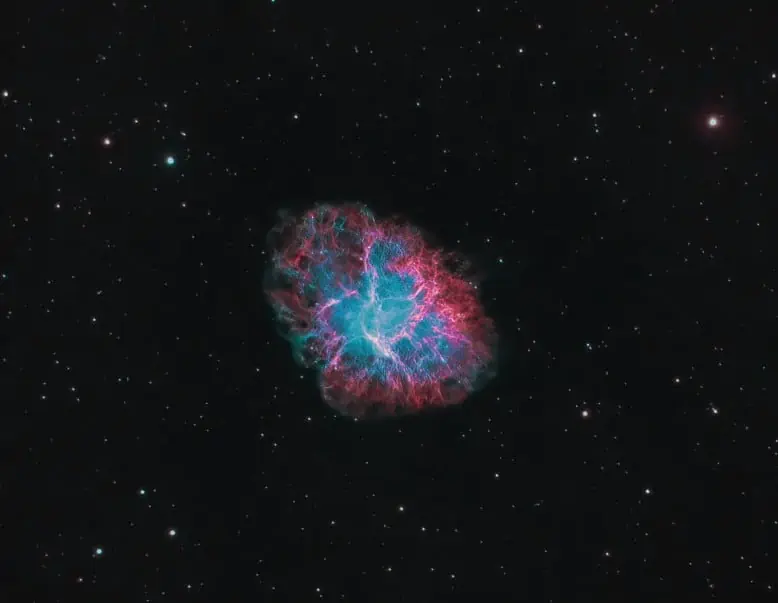
Our upgrade pick is the Celestron CPC Deluxe 1100 HD:
Celestron CPC 1100 EdgeHD Schmidt-Cassegrain Telescope with Tripod
- Huge 11-inch aperture optimized for astrophotography
- All you need in one package, with telescope, mount, and tripod
- Computerized mount finds objects for you to view at a press of a button
- Used by Stephen Hawking
This was the telescope used at home by Stephen Hawking.
It is an extremely powerful 11-inch Schmidt-Cassegrain telescope combined with Celestron’s computerized CPC mount.
This is an advanced all-in-one package for those with a higher budget but gives you the very best telescope for both astronomy and astrophotography.
As noted above, Schmidt-Cassegrains (SCTs) are one of the best telescope types for astrophotography and this is one of the most powerful options available in 2024.
The EdgeHD in the name refers to how the telescope has been optimized for deep sky imaging but, like the Celestron NexStar above, to excel for astrophotography you can add the Pro Wedge to improve the smooth tracking ability of the mount.
Here is an example image taken with a Celestron 11-inch EdgeHD telescope:
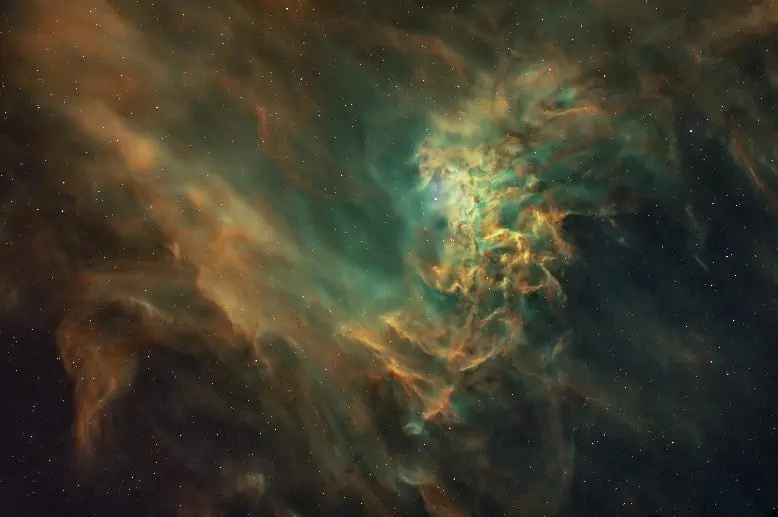
Our budget pick is the Sky-Watcher Quattro 200/800:
Value Imaging Newtonian Telescope for Astrophotography
- Large 8-inch Aperture
- 800mm Focal Length
- Fast F/4 Focal Ratio
- Great value for the price
This is an imaging Newtonian type telescope that gives you a great price-to-aperture ratio with a powerful telescope at a relatively cheap price.
Our results show that this is one of the most successful telescope models for deep sky astrophotography and is a great option for people looking to build a serious imaging setup without spending thousands.
Best Telescope for Astrophotography: Data Analysis
We analyzed all 685 images shortlisted for the Astronomy Photographer of the Year competition for the past five years (2018 to 2022) to see what telescopes were used.
Of these 685 images, 342 used telescopes (the others used just camera lenses etc) and so we can examine these to see the most successful astrophotography telescopes.
Overall, we see that Celestron models are the most popularly used telescopes, followed by those made by Takahashi, Sky-Watcher, and PlaneWave:
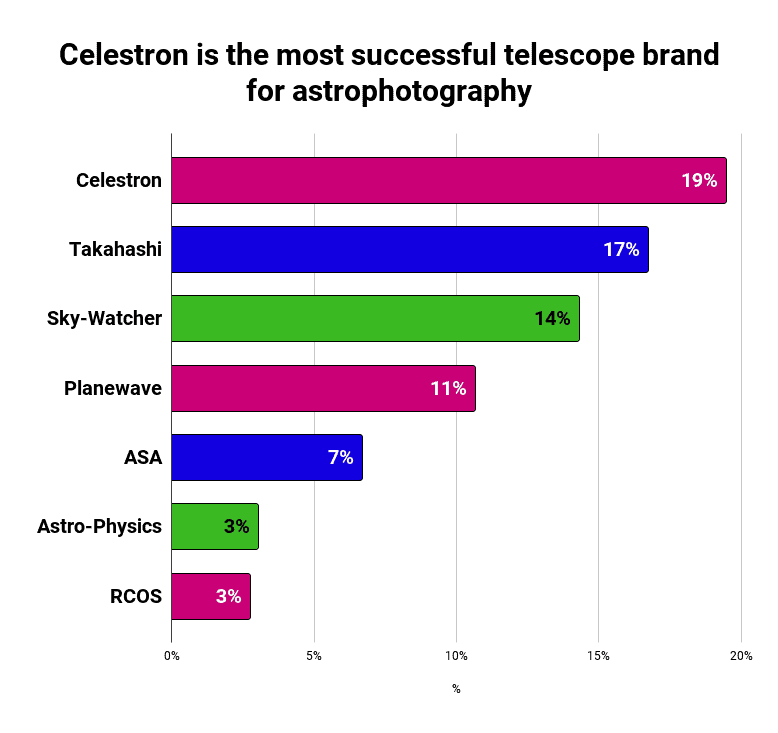
As for telescope types, apochromatic refractors and Schmidt-Cassegrains are the two most commonly (and successfully) used:
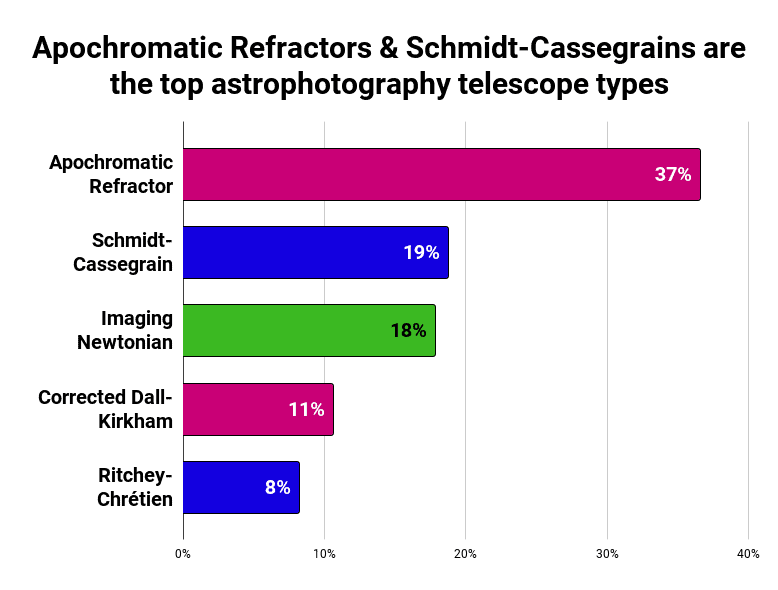
The Takahashi FSQ-106 is the most successfully used individual telescope model in five years of the competition:
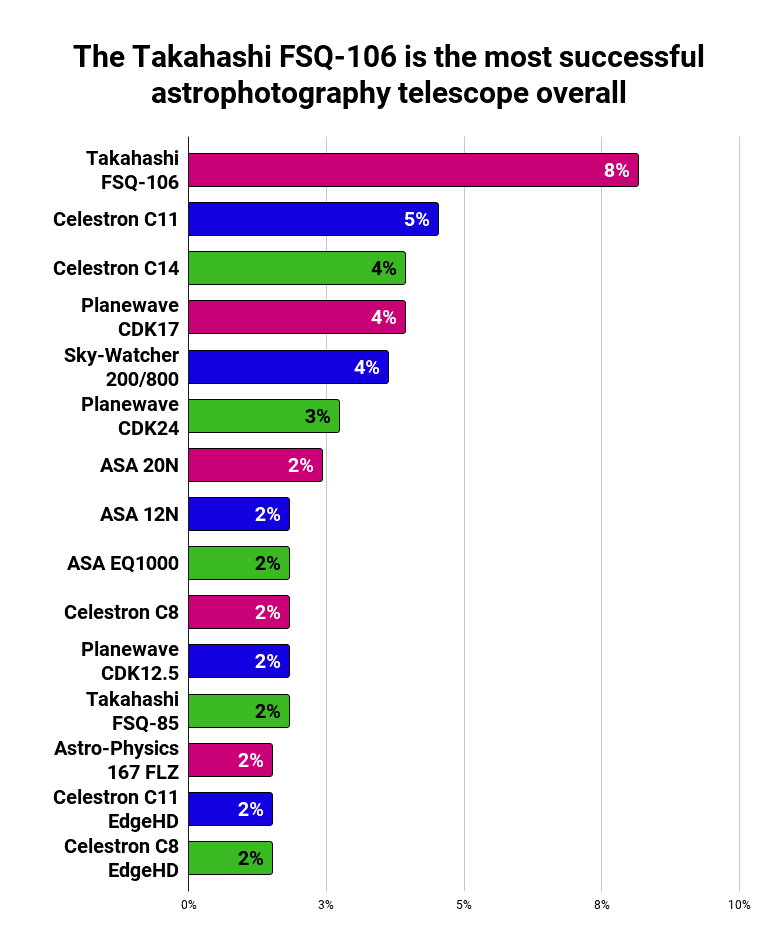
This telescope is a quadruplet apochromatic refractor telescope.
It is generally very hard to find available to buy in 2024 which is why we have recommended an alternative Takahashi model in this article.
Telescopes for Planetary Astrophotography
If we focus on planetary imaging, we see that Celestron is the most successful manufacturer by some distance, with Sky-Watcher in second:
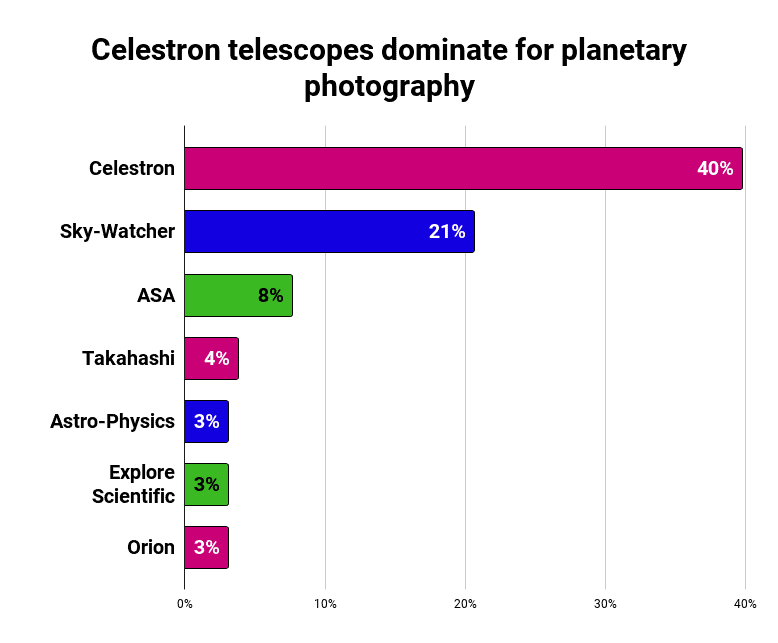
This is then reflected in the top telescope types that are used in planetary imaging, with Schmidt-Cassegrains (made by Celestron) at number one:
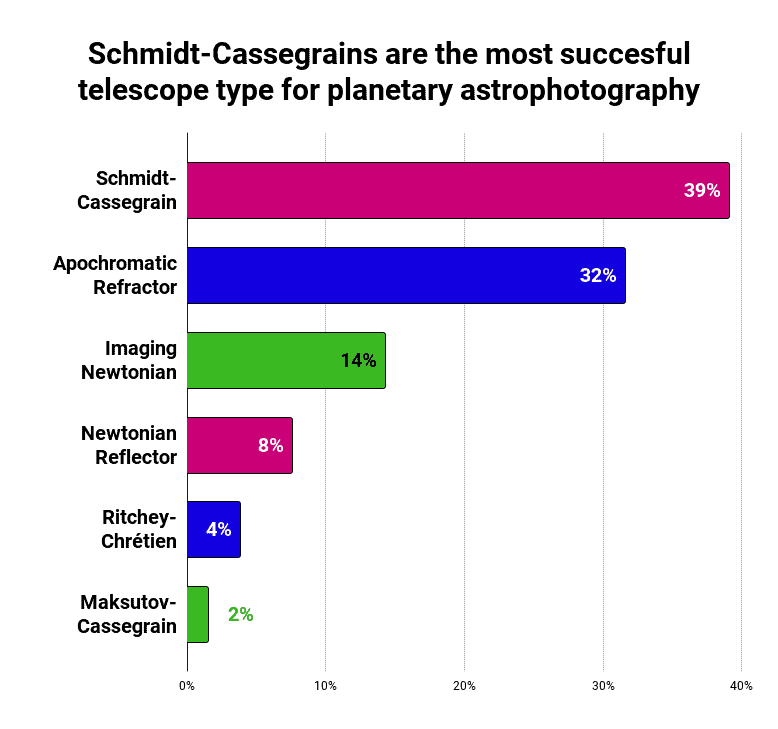
This is why we recommend the Celestron NexStar 8SE as a great entry-level option and the Celestron CPC 1100 HD as the best upgrade option.
The highest aperture Celestron C11 and C14 Schmidt-Cassegrains are the most popularly used individual optical tube assemblies (OTAs) for planetary imaging:
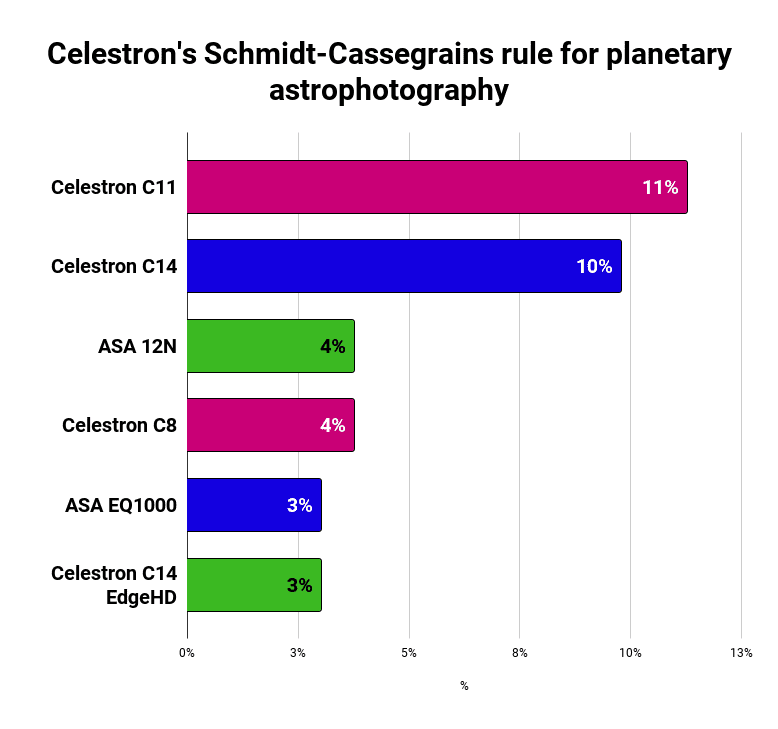
The C11 is an 11-inch aperture SCT, the C14 is 14-inch, and the C8 is 8-inch.
They can be bought as standalone OTAs or as part of packages with mount included – like the Nexstar 8SE and the CPC 1100 HD recommended here.
For more detail on planetary telescopes, see our article on the Best Telescopes for Planetary Imaging.
Telescopes for Deep Sky Astrophotography
If we look at telescopes for deep sky imaging we see Takahashi and Planewave leading:
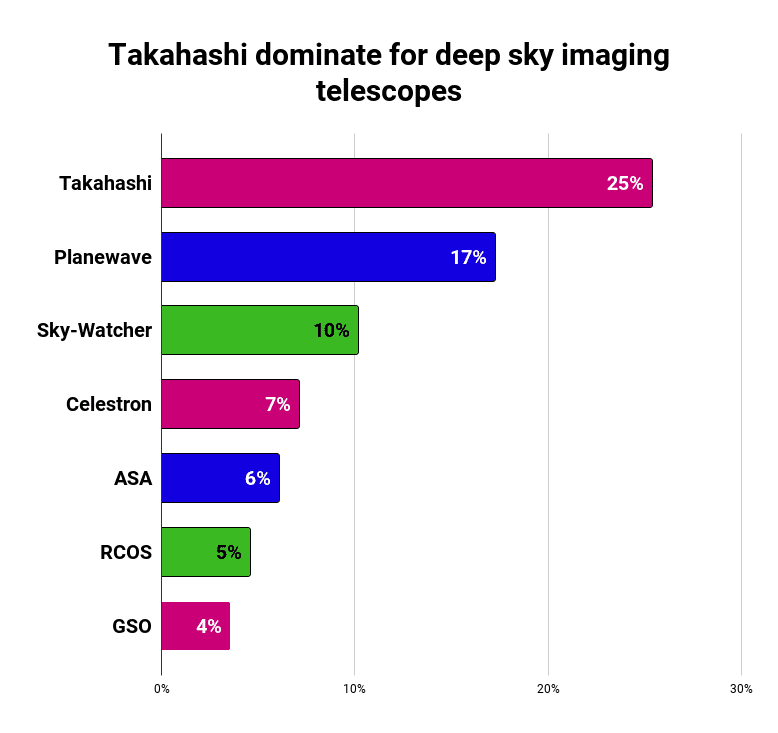
Apochromatic refractors are then the most commonly used telescope type, followed by imaging newtonians:
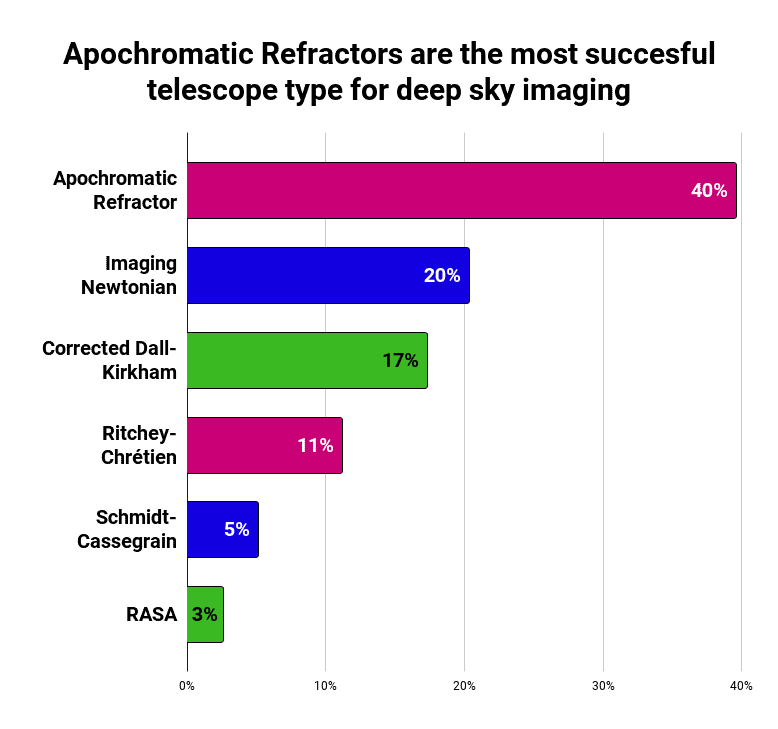
Apochromatic refractors and imaging newtonians are both telescope types that can be acquired relatively cheaply and so are accessible to more people (although many premium models do exist).
Corrected Dall-Kirkham (CDK) telescopes from Planewave are observatory-grade, ultra-premium telescopes.
The top three individual models are then:
- Takahashi FSQ-106
- Planewave CDK17
- Sky-Watcher Quattro 200/800
You can see the top 12 here:
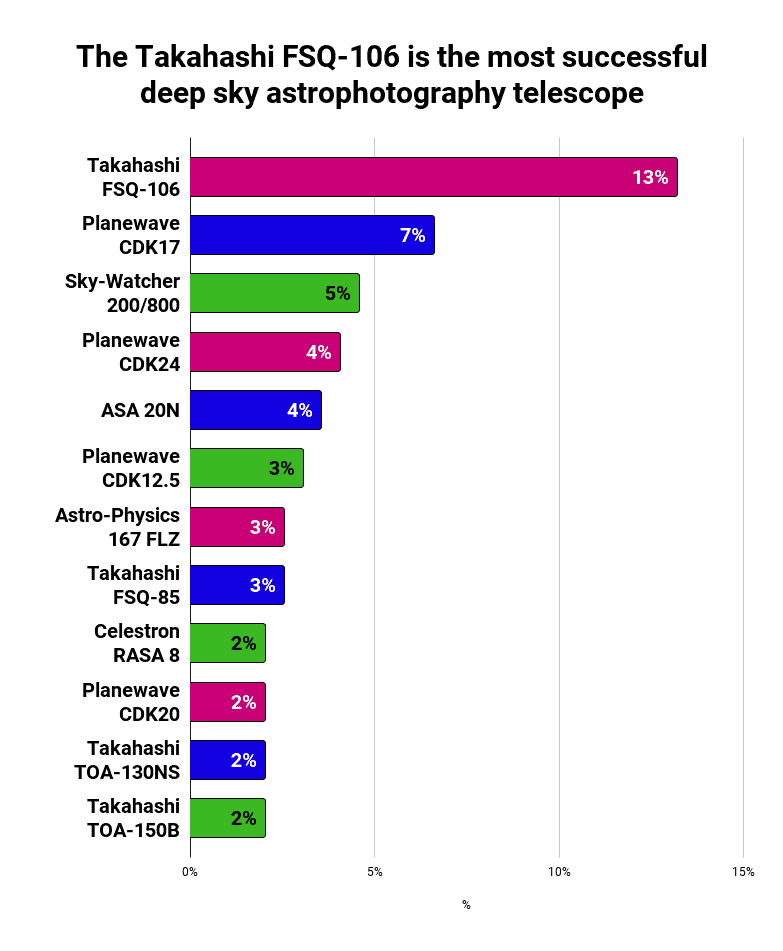
We will now examine each of the top models that we recommend and explore the pros and cons of each.
Best Telescopes for Astrophotography
Celestron NexStar 8SE
Best Telescope for Astrophotography for Beginners
Our number one pick for beginners is the Celestron NexStar 8SE.
Our research shows that this type of telescope (a Celestron Schmidt-Cassegrain) is one of the best for astrophotography, especially for planetary photography.
It has an 8-inch aperture, which is large and will provide great views. It comes with a quality computerized mount so that you have all you need in one.
We have selected this model as:
- It’s a great all-in-one package that will work well for both astronomy and astrophotography
- It’s relatively affordable compared to some of the other 11-inch or 14-inch SCTs (they get more expensive as the aperture gets larger)
You can watch a quick overview of the Nexstar SE telescopes here:
Pros
- Great Schmidt-Cassegrain telescope OTA that our results show is proven for astrophotography
- Large 8-inch aperture for great light gathering
- Long focal length is especially good for viewing and photographing planetary objects
- Perfect all-in-one bundle for someone looking for a great telescope to use for both astronomy and astrophotography
Cons
- Relatively expensive
- Fairly heavy and bulky
- You need to buy an additional equatorial wedge to get the very best out of this model for deep-space astrophotography
Here is an excellent overview of this telescope from the perspective of a beginners option for astrophotography:
The same 8-inch Schmidt Cassegrain telescope tube can be bought as a standalone OTA, or as part of the NexStar Evolution 8 package but the Nexstar SE bundle is cheaper and so we have made this our pick here – see Celestron Nexstar Evolution 8 vs Nexstar 8SE if you want to compare further.
There is also an Evolution HD version, which has some features to make it better for astrophotography but is more expensive, and a Celestron 8-inch RASA, which has a shorter focal length to make it better for deep sky imaging but it is more expensive still.
As an alternative budget option, there are also smaller (lower aperture) models in the same range that are cheaper. See the:
Overall, the Nexstar 8SE is a great all-in-one bundle that is relatively easy to use and perfect for someone looking for an all-in-one package to get into astrophotography.
Key specifications
- Type: Catadioptric (Schmidt-Cassegrain)
- Aperture: 8 inch (203 mm)
- Focal Length: 80 inch (2032 mm)
- Focal Ratio: f/10
- Weight: 40.5 lbs (18 kg)
- Mount: Alt-Azimuth (Computerized)
Celestron CPC Deluxe 1100 EdgeHD
Best Astrophotography Telescope Bundle
Our upgrade pick is the Celestron CPC Deluxe 1100 HD telescope package.
This was the telescope used at home by Stephen Hawking.
It is an extremely powerful 11-inch Schmidt-Cassegrain telescope combined with Celestron’s computerized CPC mount.
This is an advanced all-in-one package for those with a higher budget but gives you the very best telescope for both astronomy and astrophotography.
As noted above, Schmidt-Cassegrains (SCTs) are one of the best telescope types for astrophotography and this is one of the most powerful options available.
The EdgeHD in the name refers to how the telescope has been optimized for deep sky imaging by correcting for the coma that is inherent in SCTs. This means that the stars should stay sharp and clear right up to the edges of images.
It has an f/10 focal ratio, but it also has a functionality that Celestron calls Fastar that allows the telescope to be converted to a much faster f/2 focal ratio.
You can watch this video from Celestron for a quick overview of this telescope range:
Pros
- Huge 11-inch aperture for great light gathering – the OTA in this package (the C11) is the most successfully used model for planetary imaging in our data
- EdgeHD OTA optimized for deep sky astrophotography (and astronomy) and corrects the Coma that is inherent in regular SCTs
- Great computerized mount that is easy to use
Cons
- Expensive
- Ideally, for deep sky astrophotography, you should add the Pro Wedge to increase the smooth tracking ability of the mount.
Overall, this is a great option if you have the budget and you want the best all-in-one package you can just setup and get stuck into at home for both looking through and for astrophotography.
Key specifications
- Type: Catadioptric (Schmidt-Cassegrain)
- Aperture: 11 inch (280 mm)
- Focal Length: 110 inch (2800 mm)
- Focal Ratio: f/20 (but can be adapted to f/2 using the Fastar option)
- Weight: 93 lbs (42 kg)
- Mount: Celestron CPC Computerized (GOTO) Fork Mount
Sky-Watcher Quattro 200P
Best Budget Telescope for Astrophotography
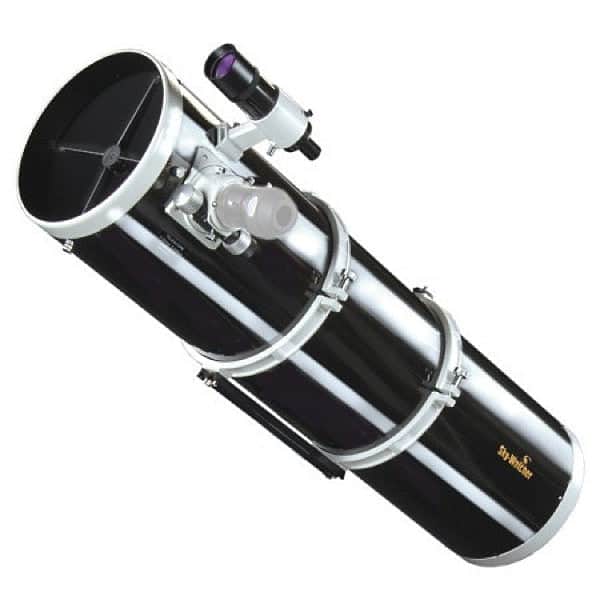
Our astrophotography competition data above shows that this telescope is the third most successful telescope for deep-sky imaging, and fifth most successful overall.
It is a relatively budget telescope and so is notable that it is holding its own alongside some really advanced specialist telescopes that cost a lot more.
This is a real bargain if you can find it in stock. You get a large 8-inch aperture and an extremely fast focal ratio of F/4.
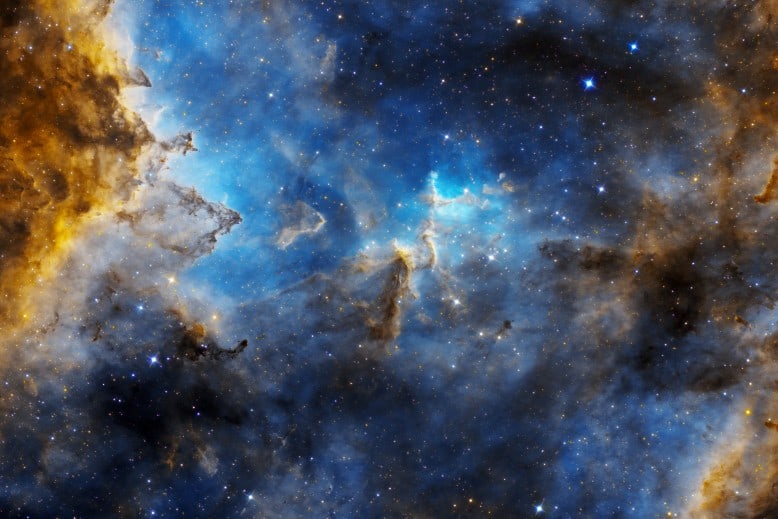
Pros
- Proven performer for deep space astrophotography
- Great value in terms of aperture to price
Cons
- Fairly large and bulky and not so portable
- Not a package, so you will have to have a separate mount
Overall, reflectors like this are slightly harder to handle than refractors due to the weight and size but this provides great value and our findings show that it can produce astronomy images at the highest level.
It also works for both observing and imaging, which is an advantage over the apochromatic refractor models (like the Takahashi above).
There are also 10-inch and 12-inch versions of this telescope available that are more powerful but more expensive.
Key specifications
- Type: Newtonian Reflector
- Aperture: 8 inch (203 mm)
- Focal Length: 31.4 inch (800 mm)
- Focal Ratio: f/3.9
- Weight: 21 lb (9.5 kg)
- Mount: Not included
FAQs: Astrophotography Telescopes
Which type of telescope is best for astrophotography?
There are broadly three types of telescope that work well for astrophotography:
- Catadioptric telescopes – like the Celestron Schmidt-Cassegrain models. These are great for both observing and imaging. Depending on the size you get these can be reasonably compact but can get fairly large and heavy. These are particularly good for planetary photography.
- Apochromatic refractors – these can be very small and portable (but get bigger at higher apertures). They are used exclusively for imaging and not observing. They are particularly good for deep sky imaging.
- Newtonian Imaging telescopes – these tend to be very large and bulky but generally give the best bang for buck in terms of power for price. These are also mostly good for deep sky imaging.
What is best for you will depend on your budget and preferences regarding size and ease of use.
Aside from the telescope type, you also need to consider whether to buy as a bundle with a telescope, mount, and tripod all in one, or to just buy the telescope tube (OTA) and get the other bits separately.
Can you do astrophotography with any telescope?
You can definitely do some form of astrophotography with any telescope, the best telescope types for astrophotography are listed above.
One thing that is key is having an equatorial mount, rather than alt-azimuth. Broadly, alt-az mounts are good for astronomy, and equatorial are good for astrophotography.
This is why dobsonians are great for observing but not so good for astrophotography, since the dobsonian mount is a version of an alt-az.
Note the Celestron packages recommended in this article use alt-az mounts, but these can be converted to (effectively) equatorial with the addition of a component called a wedge.
What size telescope do I need for astrophotography?
It depends on what type of telescope you go for.
Telescope size is usually measured in aperture, with the higher this is the better the telescope will be as it means that it can gather more light and produce better visuals and images.
However, apochromatic refractors used for astrophotography can often have fairly small apertures due to the fact that they:
- Have short focal lengths to allow wide-field imaging
- Will be used with high-resolution cameras
- Will be used with high-quality mounts
This then means that you can shoot long exposures to gather the light for the image and so the need for high aperture diminishes.
In short, higher aperture is better but it is not as important when compared to using a telescope for astronomy where you need the high aperture to create an visual good enough for you to look at in real time with your eyes. Whereas for astrophotography you can build a setup that gathers the light needed over a long exposure.
What’s the best telescope focal length for astrophotography?
Higher focal lengths are better for photographing the moon and planets, as you are zooming in closer to objects that are relatively near to the earth.
Lower focal lengths are better for deep space imaging, as you are capturing a wider expanse of space as these objects are much larger and further away.
One thing to pay attention to is the focal ratio. This is the f-number (f/2, f/10, etc) which is calculated by focal length divided by aperture.
The lower this is, the better, as it indicates that the telescope is faster and better for imaging.
What’s the best telescope for astrophotography beginners?
There are a few options for beginners’ astrophotography telescopes:
- We recommend here a telescope package like the Celestron Nexstar 8SE, or one of the smaller options in the same range (the 4SE, 5SE and 6SE). This is because they are easy-to-use bundles with everything you need all in one and are also great quality telescopes.
- If you have a DSLR or similar camera, you could go for a small apochromatic refractor telescope.
- If you want the absolute easiest option and have the money then you could consider a smart telescope – see our article on the Best Smart Telescopes (Stellina vs eVscope 2 vs eQuinox vs Vespera).
What are the best telescopes for astrophotography with DSLR cameras?
Any of the telescopes recommended above can be used with a DSLR camera (or mirrorless camera).
You just need the correct adapters to attach it (see below) and a mount that can take the weight of the telescope and camera together.
How to connect a camera to a telescope?
The best way to use a DSLR to take photos through a telescope is to attach the camera directly to the eyepiece of your telescope.
This can be done with the addition of two small pieces of extra equipment:
- A T-Ring – this fits into your camera where the lens would normally go
- A T-Adapter – this connects to your telescope eyepiece
Unfortunately, these items are not universal and you need to make sure you get the right T-Ring for the camera you have, and the right T-Adapter for the telescope you have.
To attach your camera to a Celestron telescope you will need the Celestron T-Adapter, and a T-Ring for Canon cameras or for Nikon cameras.
How to connect a smartphone to a telescope?
Adapters are available to connect smartphones to telescopes to enable you to take photographs with your phone. See the:
- Celestron NexYZ 3-Axis Universal Smartphone Adapter
- Celestron Basic Smartphone Adapter
- Gosky universal smartphone telescope adapter
If you are interested in this then you might like to read our guide to smartphone astrophotography.
What’s the best telescope for photographing the planets?
Celestron Schmidt-Cassegrain telescopes are best for photographing the planets. Like the top two recommendations in this article.
The planets of our solar system are much farther away than our moon, but much closer than far-off galaxies.
For photographing the planets, you want a long focal length. This is important for planetary photography because you want to get as close as possible to the object you are shooting (a planet) and it is (relatively) small and close.
We have a separate article dedicated to the Best Telescopes For Planetary Imaging if you would like more on this.
What’s the best telescope for deep sky astrophotography?
For deep sky imaging, you are shooting something much fainter farther away. The best telescope is therefore one with a large aperture and fast focal ratio.
This is because you are taking images for longer periods and need to gather as much light as possible. The larger the aperture, the greater the light gathering.
A short focal length can also be optimal because with longer focal lengths put greater demands on your mount. This means small tracking errors are magnified with long focal lengths.
Therefore apochromatic refractors can be perfect for deep sky imaging, as can be catadioptric telescopes with large apertures.
What’s the best telescope for photographing the moon?
For photographing the moon, if the conditions are right (i.e. no clouds), you don’t need much aperture in your telescope as it is very bright already.
A long focal length will allow you to get close in and a lower-spec telescope even with just a smartphone can get great results.
Obviously, there are levels to this and some astrophotographers use advanced gear to create HD lunar images.
What’s the best telescope for photographing the sun?
Photographing the sun is a separate practice altogether and requires strong filters.
It goes without saying, never look directly at the sun through your telescope or camera as you can do serious damage to your eyes.
Some telescope manufacturers offer specialist solar photography telescopes with the filters in built.
What is the best telescope with a camera?
Hybrid telescopes with built-in cameras are relatively new developments but make brilliant options for beginners looking to get into astrophotography in as simple a manner as possible.
Check out our article on telescopes that can take pictures (Stellina vs eVscope).
What is the best GOTO telescope for astrophotography?
We would recommend one of the Celestron packages that combine a Schmidt-Cassegrain telescope with a GOTO mount like the top two recommendations in this article.
What is the best astrograph telescope?
An astrograph is a category of telescope that works just for imaging and not observing.
The Planewave and Takahashi models recommended in this article are astrographs.
See our article on What is an Astrograph Telescope? for more insight on this.
Can a dobsonian telescope be used for astrophotography?
Yes, dobsonians can be used for astrophotography by attaching DSLR/mirrorless cameras or dedicated CCD/CMOS astronomy cameras with the right adapters, however, the dobsonian mount is not ideal for imaging as it is an alt-az rather than equatorial.
Are Newtonian telescopes good for astrophotography?
Regular newtonian reflectors can be used for astrophotography but tend to be bulky.
Imaging newtonians are a version optimized for astrophotography and the Sky-Watcher 8″ Quattro Imaging Newtonian is one of the most successful astrophotography telescopes in our research.
Do you need an equatorial mount for astrophotography?
Equatorial mounts are better for astrophotography as they can smoothly track the object in the sky in any direction.
The other type of mount is an alt-azimuth which tracks only in up-down, left-right directions and is much easier to use for astronomical observing.
See the best telescope mounts for astrophotography for recommendations.
Verdict: What’s the best telescope for astrophotography?
In summary, we recommend the:
- Celestron Nexstar 8SE as the best astrophotography telescope package for beginners
- Celestron CPC Deluxe 1100 HD as the upgrade pick for those with bigger budgets that want the best home package
- Sky-Watcher 200/800 Quattro as the best budget telescope for astrophotography
We hope you found this article and research useful to help you find your telescope for astrophotography.
Please let us know if you have any thoughts on what we’ve covered here in the comments below.


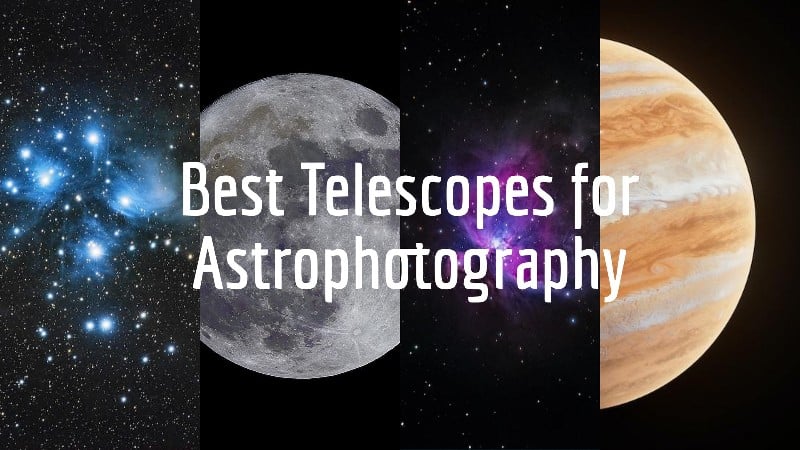
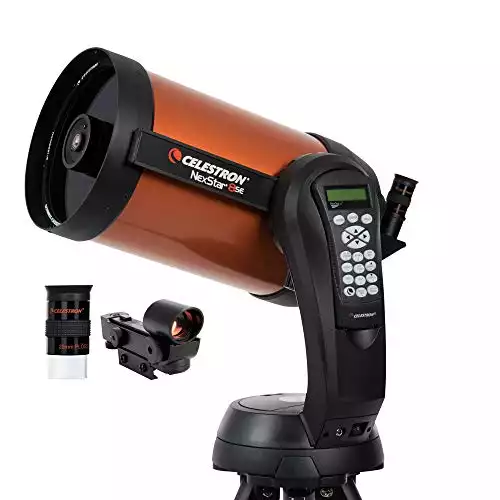
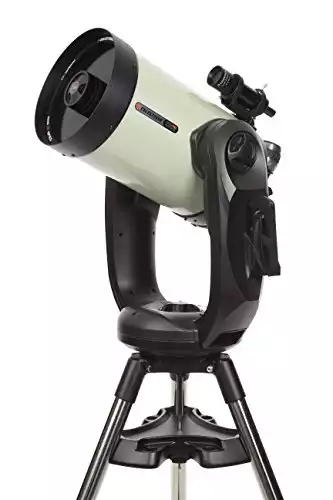
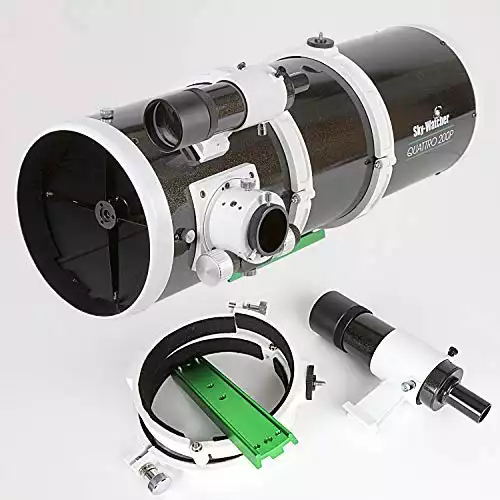




The article I was reading was explaining EAA and it sent me to this page which seems to talk ONLY about astrophotography. Are all the varied scope types, and scopes themselves, mentioned here equally good for EAA use or do I need to look elsewhere for an appropriate EAA scope? (If so, where look??)
Thanks for your response.